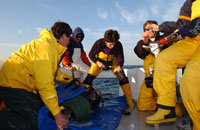 |
| The Wave Glider Carey begins her latest mission |
A mobile robot called a Wave Glider outfitted with acoustic
receivers to detect free-swimming tagged fish was put in the ocean off the
coast of Beaufort, North Carolina today. The glider was launched from the Duke
ship R/V Susan Hudson outside the Beaufort Inlet by Drs. Dick Barber and Joe
Bonaventura of Duke
University North Carolina
seaboard, scientists from Stanford, Duke and Eastern
Carolina University
are working together to listen for tagged bluefin tuna, striped bass and
sturgeon that overwinter in North
Carolina waters.
Monitoring marine species is valuable not only for the data
about their whereabouts but also to better understand our changing oceans and climate.
These species can act as roving reporters providing knowledge of their presence
or absence in relationship to ocean conditions.
Bluefins and striped bass overwinter in the coastal waters of North Carolina to feed
on Menhaden an oily forage fish that is a coastal favorite of both species.
“I am really enthusiastic about the role of the Wave Glider,
this new ocean robot, to help us detect where fish are” said Dr. Barbara Block
a professor from Stanford
University Carolina coast and we’re
now moving into the phase of developing techniques to long-term monitor their presence
or absence along the eastern Seaboard. The glider provides an opportunity to
experiment with how to do this in the rough winter conditions of the Hatteras
coastline.”
 |
| The TAG team tags a giant bluefin |
In addition, ECU professor Roger Rulifson is leading a team
on the R/V Cape Hatteras, an NSF ship managed by Duke University Carolina coast.
 |
| Duke University Professor Dick Barber stands with the Carey glider |
The glider is was deployed by two of Block’s mentors, Drs.
Joe Bonaventura and Dick Barber from Duke University North Carolina ,”
says Professor Dick Barber. “I was fortunate to know Frank Carey, the pioneering
tuna scientists from Woods Hole Oceanographic, and a Duke Post-doc, after whom
the Carey Glider was named, and he would be very pleased to know of the
experimental importance of this mission- chasing Atlantic bluefin and striped
bass off our coast”.
The Wave Glider is manufactured by Liquid Robotics of
Sunnyvale California. The project is funded by a Rolex award to Block, The Tag
A Giant Fund, Duke University , Stanford University




No comments:
Post a Comment